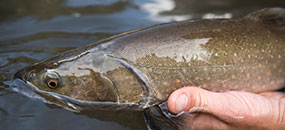FOR IMMEDIATE RELEASE:
October 1, 2007
CONTACT:
Dr. Peter Kolesar: Columbia University, 212-854-4105
Steve Lieb: Theodore Gordon Flyfishers, 201-788-7299
Larry Miri: The Fly Fishing Connection, 845-986-0473
Erin Mooney: Trout Unlimited, 703-284-9408
Jim Serio: Delaware River Foundation, 607-637-3220
Conservation Coalition Sees Improvement in New Delaware River Flow Plan
New York, NY---A new flow plan for the Delaware River and three Catskill reservoirs that provide drinking water to New York City represents an improvement from the current system, according to a broad conservation coalition that has been working to change the system’s plan for water management.
Last week, New York State, New Jersey, Pennsylvania, Delaware and New York City agreed to implement an interim Flexible Flow Management Plan (FFMP) for the Delaware River. On September 26 the Delaware River Basin Commission (DRBC) voted to move forward with the public hearing process for the interim FFMP which will be implemented on October 1.
“This is a step in the right direction for protecting the ecological integrity and recreational activities on the Upper Delaware River while protecting water supply for Pennsylvania, New Jersey and New York City,” said Jim Serio, President of the Delaware River Foundation.
The coalition includes representatives from the Delaware River Foundation, the Deming Center at Columbia University, The Fly Fishing Connection, Theodore Gordon Flyfishers, and Trout Unlimited.
The interim FFMP will maintain more consistent water releases from three New York City reservoirs in the Catskills—the Cannonsville, Pepacton and Neversink. These reservoirs provide drinking water to over five million New York City residents.
This new FFMP will regulate water releases from the reservoirs into the east and west branches of the Delaware and the Neversink rivers. In contrast to previous plans, the new FFMP calls for seasonal adjustments to the water releases and will alter releases according to reservoir water levels.
In the next few months, the coalition will examine the interim FFMP using several computer models to identify strengths and weaknesses in the program including its impact on habitat. The coalition will also determine how it compares to CP2, the coalition’s preferred water management plan. After a complete analysis of the FFMP, the conservation coalition will issue a formal position on the plan.
“We are confident that additional opportunities exist to increase water releases above those outlined in the interim FFMP without jeopardizing water supply,” said Elizabeth Maclin, Eastern Conservation Director at Trout Unlimited.
The interim FFMP provides more water than the basic releases under the previous Revision 1 and Revision 7 plans, particularly during drought periods. For decades, the east and west braches of the Delaware directly downstream of these reservoirs have been plagued with low and erratic releases that have frustrated local communities and have had a negative impact on the river environment.
The DRBC will begin a public comment period on December 3, 2007. Based on the comments received, monitoring of how the FFMP actually performs during the interim period and further analysis, the DRBC will determine if changes to the interim FFMP are appropriate and then will move to adopt a permanent FFMP.
Two major concerns of the conservation coalition are that any FFMP, including the new plan: (1) allows for more flexibility and higher releases from the Cannonsville reservoir in the summer because of the benefit these releases have on river habitat; and (2) eliminates the drastic water fluctuations that occur on the Delaware River’s main stem and west branch due to current hydropower operations.
The details of the flow releases can be found on the DRBC website: www.state.nj.us/drbc
-30-
Date: 10/1/2007



